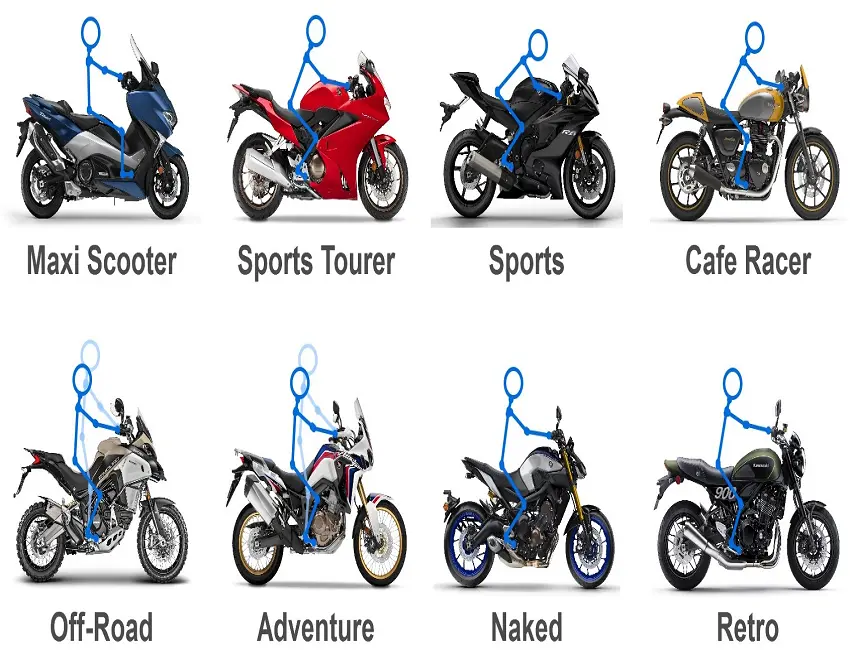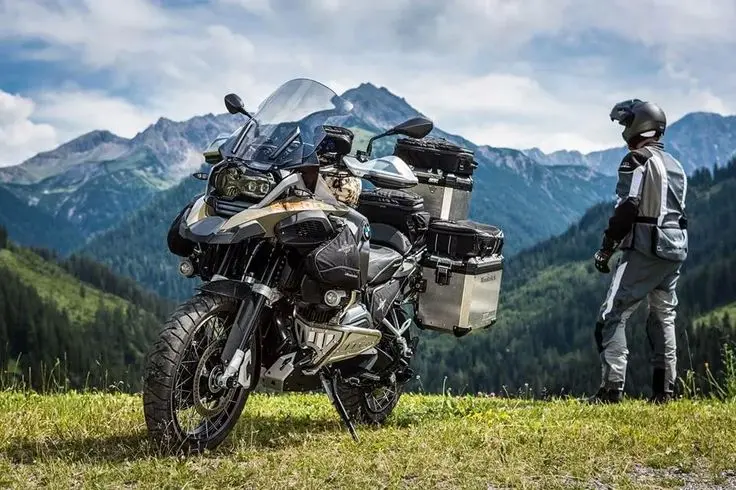In the exhilarating world of two-wheeled freedom, Types Of Motorcycles span a diverse spectrum, each designed to cater to specific riding styles, terrains and preferences.
Whether you’re a seasoned rider looking to switch things up or a newcomer eager to join the motorcycle community, understanding the various types of motorcycles is crucial in finding your ideal match.
This comprehensive guide will take you on a journey through the rich tapestry of motorcycle types, from the sleek sport bikes that dominate racetracks to the rugged adventure motorcycles that conquer both highways and dirt trails.
The Evolution of Motorcycles: From Steam to Electric
Before we dive into the specifics of modern motorcycle types, let’s take a quick ride through history. The evolution of motorcycles is a testament to human ingenuity and our endless pursuit of faster, more efficient transportation.
The Early Days: Steam Power and Bicycles with Engines
The concept of a motorized bicycle dates back to the 1860s when Pierre Michaux, a blacksmith in Paris, attached a small steam engine to a bicycle. This invention, while groundbreaking, was still far from the motorcycles we know today.
It wasn’t until 1885 that the first true motorcycle emerged. German inventors Gottlieb Daimler and Wilhelm Maybach created the Daimler Reitwagen, featuring a gasoline-powered engine.
Key Milestones in Motorcycle Evolution
- 1894: Hildebrand & Wolfmüller becomes the first series production motorcycle, marking the beginning of the motorcycle industry.
- 1901: Indian Motorcycle Company is founded, followed by Harley-Davidson in 1903, establishing two iconic American brands that would shape motorcycle culture for decades to come.
- 1910s: The basic motorcycle design is established with a steel frame and fork, setting the foundation for future innovations.
- 1930s: Telescopic forks and rear suspension systems are introduced, greatly improving ride comfort and handling.
- 1950s-1960s: Japanese manufacturers like Honda, Yamaha, and Kawasaki enter the market, bringing new technologies and design philosophies.
- 1970s-1980s: Specialization of motorcycle types begins, with distinct categories emerging to cater to different riding styles and preferences.
- 2000s onwards: Advanced electronics, ABS, traction control, and electric motorcycles become prevalent, ushering in a new era of safety and performance.
This rich history has led to the diverse array of motorcycle types we see today, each with its own unique characteristics and purpose. From vintage motorcycles that harken back to the early days of riding to cutting-edge electric bikes pushing the boundaries of technology, the motorcycle world continues to evolve and captivate riders worldwide.
Understanding Motorcycle Classifications
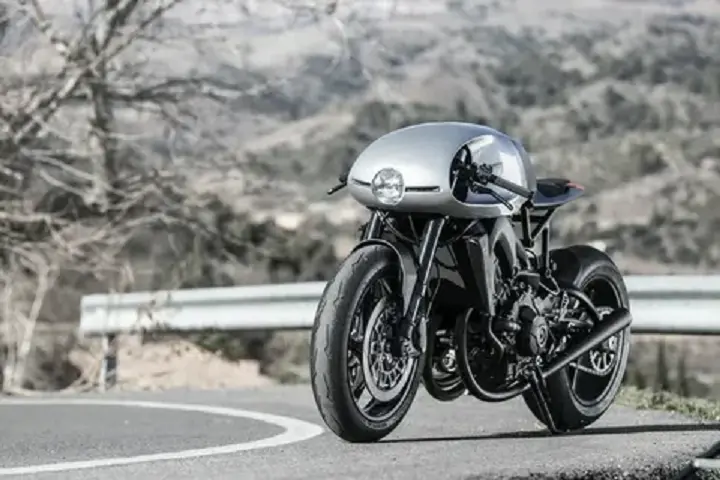
Before we delve into specific types, it’s important to understand how motorcycles are generally classified. This knowledge will help you navigate the world of two-wheelers more effectively and make informed decisions when choosing your perfect ride.
Classification by Engine Size
Motorcycles are often categorized by their engine displacement, measured in cubic centimeters (cc). The engine size significantly impacts the bike’s power, performance and suitability for different riding scenarios. Here’s a general breakdown:
| Category | Engine Size | Typical Use |
| Small | 50-250cc | Urban commuting, beginners |
| Medium | 250-750cc | All-around use, intermediate riders |
| Large | 750cc+ | Touring, experienced riders |
It’s worth noting that engine size isn’t the only factor determining a motorcycle’s performance. Modern engineering has allowed smaller engines to produce impressive power outputs, blurring the lines between these traditional categories.
Classification by Intended Use
Motorcycles are also grouped based on their primary purpose:
- Street: Designed for use on paved roads, including everything from daily commuters to high-performance sportbikes.
- Off-road: Built for unpaved surfaces, featuring rugged construction and specialized suspension systems.
- Dual-purpose: Versatile machines capable of handling both on-road and off-road riding, offering the best of both worlds.
Classification by Design Characteristics
Design features like ergonomics, fairing, and frame style also play a role in categorizing motorcycles. These characteristics often reflect the bike’s intended use and riding style:
- Ergonomics: The positioning of the handlebars, footpegs, and seat can range from upright (cruisers) to forward-leaning (sportbikes).
- Fairing: The presence and extent of wind protection, from fully-faired sportbikes to naked bikes with minimal bodywork.
- Frame style: Different frame designs cater to various needs, from lightweight trellis frames for agile handling to robust frames for carrying heavy loads.
Understanding these classification systems will help you appreciate the nuances between different motorcycle types and make a more informed decision when choosing your ride.
Street Motorcycles: Mastering the Asphalt

Street motorcycles are designed primarily for use on paved roads. They come in various styles to suit different riding preferences and purposes, from daily commuting to high-speed thrills.
Standard/Naked Bikes: The Versatile All-Rounders
Standard bikes, also known as naked bikes, are the Swiss Army knives of the motorcycle world. They offer a perfect blend of performance, comfort, and versatility, making them ideal for both daily commutes and weekend joyrides.
Key characteristics:
- Upright riding position for comfort and visibility
- Minimal fairings, exposing the engine and frame
- Mid-range engine sizes (typically 600-1000cc)
- Balanced performance suitable for various riding scenarios
- Customizable and adaptable to different riding styles
Notable examples:
- Yamaha MT-09
- Triumph Street Triple
- Kawasaki Z900
- Ducati Monster
- Honda CB650R
“Naked bikes offer the purest form of motorcycling experience. They’re honest, versatile, and incredibly fun to ride. It’s like having a conversation with the road, with nothing to hide behind.” – John Doe, Motorcycle Journalist
Standard bikes have seen a resurgence in popularity in recent years, with manufacturers introducing more powerful and technologically advanced models. The Yamaha MT-09, for instance, boasts a 890cc triple-cylinder engine producing 117 horsepower, while maintaining a lightweight and agile chassis.
Sport bikes: Speed Demons of the Road
For those with a need for speed, sportbikes deliver unparalleled performance and handling. These machines are built for velocity and agility, often featuring technology derived from racing motorcycles.
Key features:
- Aerodynamic fairings to reduce drag
- High-performance engines tuned for top-end power
- Aggressive riding position for optimal control at high speeds
- Advanced suspension systems for precise handling
- Lightweight materials like carbon fiber to improve power-to-weight ratio
Popular models:
- Kawasaki Ninja ZX-10R
- Ducati Panigale V4
- Honda CBR1000RR-R Fireblade
- Yamaha YZF-R1
- BMW S 1000 RR
Sport bikes boast impressive power-to-weight ratios, often exceeding 1:1. For instance, the Ducati Panigale V4 S produces 214 horsepower while weighing just 430 pounds dry, resulting in a power-to-weight ratio of 1.18:1. This incredible performance comes at the cost of comfort for long rides and practicality for daily use.
Case Study: Evolution of the Honda CBR Series Honda’s CBR series exemplifies the rapid advancement of sport bike technology:
- 1987: CBR600F introduced, balancing performance and practicality
- 1992: CBR900RR Fire blade revolutionizes the class with its lightweight design
- 2004: CBR1000RR introduced, featuring Unit Pro-Link suspension
- 2020: CBR1000RR-R Fire blade SP debuts with MotoGP-derived aerodynamics and 215 hp
This evolution showcases how sport bikes have pushed the boundaries of motorcycle engineering, influencing other categories along the way.
Cruisers: Laid-Back Luxury on Two Wheels
Cruisers embody the spirit of relaxed, open-road riding. These motorcycles prioritize style and comfort, often featuring classic designs inspired by American motorcycles of the 1930s to 1960s.
Defining traits:
- Low seat height for easy reach to the ground
- Forward-set footpegs for a relaxed riding position
- Wide handlebars for easy, laid-back control
- V-twin engines (typically) for strong low-end torque
- Emphasis on customization and personal expression
Iconic examples:
- Harley-Davidson Softail
- Indian Scout
- Yamaha V Star
- Honda Fury
- Triumph Bonneville Bobber
Harley-Davidson, synonymous with cruisers, has been producing these iconic machines since 1903. Their 2021 lineup features 32 different cruiser models, showcasing the enduring popularity of this motorcycle type. Cruisers often serve as a canvas for customization, with many riders modifying their bikes to create unique custom motorcycles that reflect their personal style.
Subcategories of Cruisers:
- Choppers: Characterized by extended front forks and minimalist design
- Bobbers: Stripped-down cruisers with shortened rear fenders
- Baggers: Cruisers equipped with saddlebags for increased storage capacity
Touring Motorcycles: Built for the Long Haul
When it comes to covering vast distances in comfort, touring motorcycles reign supreme. These bikes are designed for extended trips, offering ample storage, weather protection, and rider amenities.
Key features:
- Large fairings and windscreens for excellent wind protection
- Spacious luggage capacity, often including built-in saddlebags and top cases
- Comfortable seating for rider and passenger, with backrests on some models
- Long-range fuel tanks for extended rides between fill-ups
- Advanced entertainment and navigation systems
Top picks:
- Honda Gold Wing
- BMW K 1600 GTL
- Harley-Davidson Road Glide
- Indian Roadmaster
- Yamaha Star Venture
Case Study: Honda Gold Wing The Honda Gold Wing, introduced in 1974, has become the gold standard for touring motorcycles. The latest model, the 2021 Gold Wing Tour, boasts:
- 1,833cc flat-six engine producing 124 horsepower and 128 lb-ft of torque
- 7-speed dual-clutch transmission or 6-speed manual
- 32-liter trunk capacity, plus additional saddlebag storage
- Apple CarPlay and Android Auto integration
- Electronically adjustable suspension
- Tire Pressure Monitoring System (TPMS)
- Hill Start Assist
These features exemplify the focus on comfort, convenience, and safety that defines the touring motorcycle category.
Sport Tourers: Blending Speed and Comfort
Sport touring motorcycles strike a balance between the performance of sportbikes and the comfort of touring bikes. They’re perfect for riders who want to cover long distances quickly without sacrificing agility.
Characteristics:
- Semi-upright riding position, more comfortable than sportbikes but more aggressive than tourers
- Moderate fairings for wind protection without excessive bulk
- Hard luggage options for carrying capacity
- Powerful engines with smooth power delivery
- Advanced electronics including adjustable suspension and riding modes
Standout models:
- Yamaha Tracer 900 GT
- Kawasaki Ninja 1000SX
- BMW R 1250 RS
- Ducati SuperSport
- KTM 1290 Super Duke GT
Sport tourers offer a compelling package for riders who don’t want to compromise. The BMW R 1250 RS, for example, features a 1,254cc boxer twin engine producing 136 horsepower, dynamic electronic suspension adjustment, and optional hard luggage, all while maintaining a sporty silhouette.
Dual-Sport and Adventure Bikes: Conquering All Terrains

For riders who refuse to be limited by road conditions, dual-sport and adventure motorcycles offer the best of both worlds, combining on-road comfort with off-road capability.
Dual-Sport Motorcycles: Jack of All Trades
Dual-sports are designed to handle both on-road and off-road riding with equal competence. They’re lightweight, versatile, and perfect for riders who enjoy mixing up their terrain.
Key features:
- Long-travel suspension to absorb bumps and jumps
- Upright riding position for good visibility and control
- Knobby tires for traction on various surfaces
- Skid plates for engine protection
- Slim profile for maneuverability in tight spaces
Popular choices:
- Suzuki DR-Z400S
- Kawasaki KLR650
- Yamaha WR250R
- Honda CRF450L
- KTM 690 Enduro R
Dual-sport motorcycles often serve as excellent commuter motorcycles for riders who encounter a mix of paved and unpaved roads. Their versatility makes them popular in rural areas and developing countries where road conditions can be unpredictable.
Adventure Motorcycles: Globe-Trotting on Two Wheels
Adventure motorcycles, also known as ADV bikes, take the dual-sport concept and supersize it. These bikes are built for long-distance travel across varied terrains, from highways to rough backcountry trails.
Defining traits:
- Large fuel tanks for extended range
- Robust luggage systems to carry camping gear and supplies
- Wind protection for highway comfort
- Advanced electronics including traction control and ride modes
- Sturdy construction to handle the rigors of off-road riding
Notable examples:
- BMW R 1250 GS Adventure
- KTM 1290 Super Adventure
- Honda Africa Twin
- Triumph Tiger 900 Rally Pro
- Ducati Multistrada V4
The BMW R 1250 GS Adventure, a benchmark in this category, offers:
- 7.9-gallon fuel tank for a range of over 300 miles
- 136 horsepower from its 1,254cc boxer engine
- Up to 8.3 inches of suspension travel
- Dynamic ESA (Electronic Suspension Adjustment)
- Six riding modes for various terrain types
- Optional aluminum panniers for increased storage capacity
Adventure motorcycles have gained immense popularity in recent years, with many riders drawn to their go-anywhere capability and long-distance comfort. They’ve become the preferred choice for around-the-world trips and adventure rallies.
Off-Road Motorcycles: Embracing the Dirt
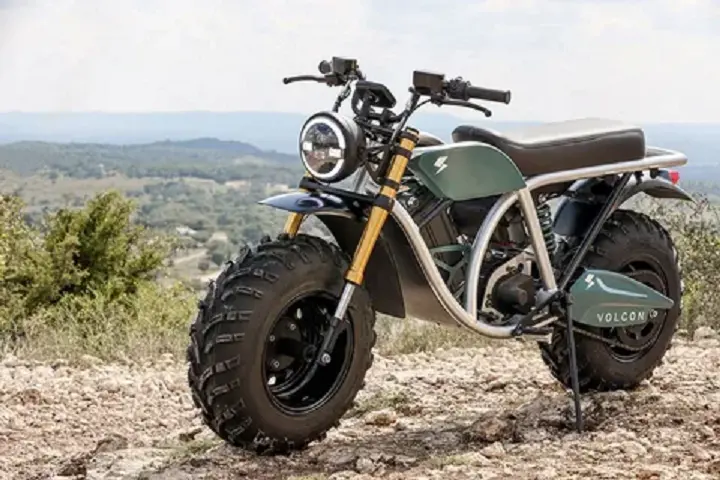
For those who prefer their rides on the wild side, off-road motorcycles offer unparalleled excitement and capability in rugged terrains. These bikes are designed to tackle everything from motocross tracks to rocky mountain trails.
Dirt Bikes: Masters of the Trail
Dirt bikes are purpose-built for off-road use, whether it’s motocross racing or trail riding. They’re lightweight, agile, and designed to handle the toughest terrains.
Key characteristics:
- Lightweight construction for easy maneuverability
- High ground clearance to clear obstacles
- Knobby tires for maximum traction in loose soil
- Long-travel suspension to absorb big jumps and rough terrain
- No lights or mirrors (for competition models)
Key players:
- Honda CRF series
- KTM SX line
- Yamaha YZ125 and YZ250
- Kawasaki KX series
- Suzuki RM-Z line
Dirt bikes are further categorized based on their intended use:
- Motocross bikes: Designed for racing on closed circuits, featuring stiff suspension and powerful engines.
- Trail bikes: More versatile for recreational riding, with softer suspension and more relaxed engine tuning.
- Trials bikes: Specialized machines for observed trials competitions, emphasizing low-speed balance and control.
Enduro Bikes: Blending Trail and Competition
Enduro bikes occupy a sweet spot between trail bikes and competition-ready dirt bikes. They’re designed for long-distance off-road riding and often feature street-legal components for dual-sport capability.
Features:
- Headlights and taillights for street legality
- Larger fuel tanks than motocross bikes for extended range
- More compliant suspension for comfort on longer rides
- Street-legal components (on some models) for versatility
- Robust construction to handle extended off-road use
Standout models:
- Husqvarna TE 300i
- Beta 300 RR
- KTM 350 EXC-F
- Sherco 300 SEF Factory
- Yamaha WR450F
Enduro bikes are popular choices for off-road racing events like the International Six Days End uro (ISDE) and various national enduro championships. They offer a compelling blend of performance and practicality for serious off-road enthusiasts.
Specialty Motorcycles: Unique Rides for Every Niche
The world of motorcycles extends beyond traditional categories, offering unique options for specific needs and preferences.
Scooters: Urban Mobility Reimagined
While not technically motorcycles, scooters deserve mention for their popularity in urban settings. They offer easy maneuverability, fuel efficiency, and convenience for short trips.
Advantages:
- Step-through design
- Automatic transmission
- Built-in storage
- Excellent fuel economy
Popular models:
- Vespa Sprint
- Honda PCX150
- Yamaha XMAX
Electric Motorcycles: The Silent Revolution
As technology advances, electric motorcycles are gaining traction. They offer instant torque, zero emissions, and lower operating costs compared to their gasoline-powered counterparts.
Key benefits:
- Instant torque
- Low maintenance
- Quiet operation
- Zero direct emissions
Pioneering brands and models:
- Zero SR/F
- Energica Ego
- Harley-Davidson Live Wire
The Zero SR/F, for instance, boasts impressive specs:
- 140 ft-lbs of torque
- 124 mph top speed
- Up to 200 miles of city range
- 1-hour charging with optional fast charger
Choosing Your Perfect Motorcycle: A Personal Journey
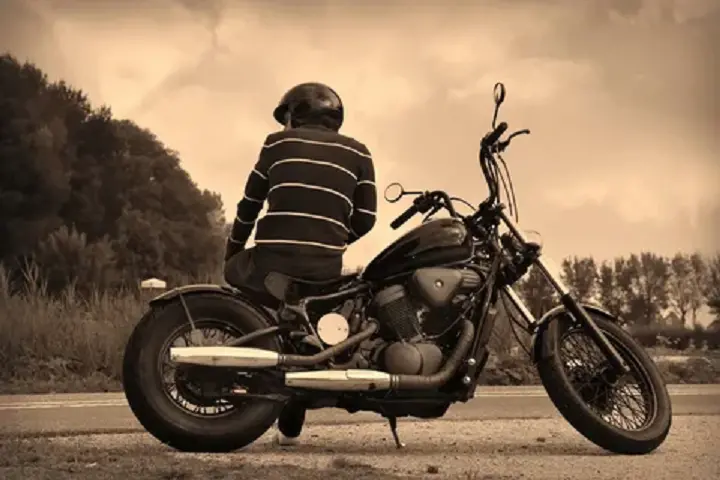
Selecting the right motorcycle type is a deeply personal decision that depends on various factors. Here are some key considerations to help guide your choice:
- Riding goals: Are you commuting, touring, off-roading, or racing?
- Experience level: Beginners might prefer less powerful, more forgiving bikes.
- Physical fit: Ensure the bike’s ergonomics match your body type and riding style.
- Budget: Consider both initial cost and long-term ownership expenses.
- Licensing requirements: Some high-powered bikes may require additional licensing.
Test Riding Tips
When evaluating different motorcycle types:
- Try various styles to understand what feels most comfortable.
- Pay attention to the bike’s weight and how it handles at low speeds.
- Test the bike in conditions similar to your intended use.
- Don’t rush – take your time to find the perfect fit.
Safety Considerations Across Motorcycle Types
Regardless of the type you choose, safety should always be a top priority. Here are some universal safety tips:
- Wear proper gear: Always use a DOT-approved helmet, protective clothing, and boots.
- Get trained: Take a motorcycle safety course to hone your skills.
- Stay visible: Use bright colors and reflective gear, especially at night.
- Maintain your bike: Regular maintenance is crucial for safe operation.
- Ride within your limits: Choose a bike that matches your skill level and riding style.
The Future of Motorcycle Design
The motorcycle industry is constantly evolving, with new technologies and trends shaping the future of two-wheeled transportation.
Emerging Technologies
- Advanced rider assistance systems: Features like adaptive cruise control and blind-spot detection are becoming more common.
- Connectivity: Integration with smartphones for navigation, communication, and vehicle diagnostics.
- Alternative powertrains: Beyond electric, we may see hydrogen fuel cell motorcycles in the future.
Sustainability Trends
Motorcycle manufacturers are increasingly focusing on sustainability:
- Eco-friendly materials: Using recycled and sustainable materials in production.
- Efficient manufacturing: Reducing carbon footprint in the production process.
- End-of-life recycling: Designing motorcycles for easier recycling at the end of their lifecycle.
Conclusion: The Unifying Joy of Motorcycling
From the sleek lines of a sport bike to the rugged capability of an adventure motorcycle, the world of two-wheelers offers something for every rider. Whether you’re drawn to the classic appeal of cruisers, the versatility of naked bikes, or the cutting-edge technology of electric motorcycles, the perfect ride is out there waiting for you.
Remember, the best motorcycle type is the one that ignites your passion for riding and suits your lifestyle. So take your time, do your research and most importantly, enjoy the journey of finding your ideal motorcycle. After all, it’s not just about the destination it’s about the thrill of the ride.
As you embark on your motorcycling adventure, keep exploring, keep learning, and above all, keep the rubber side down. Welcome to the wonderful world of motorcycles your perfect ride awaits!

With over 5 years of dedicated experience in the automotive industry, I am passionate about all things automotive. My journey began with a deep curiosity for automobiles, which led me to delve deeper into their mechanics, technology and trends. My expertise spans various aspects of the automotive world, from the latest electric vehicles to classic car restoration techniques. Through my articles, I aim to share my knowledge and insights, helping readers stay informed and inspired in the fast-paced world of the automobile.
